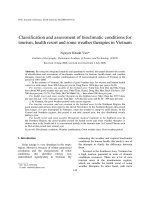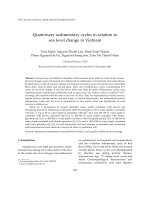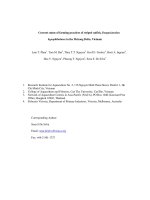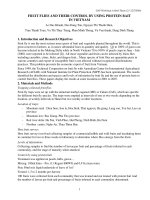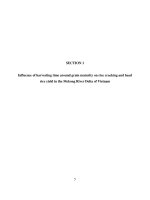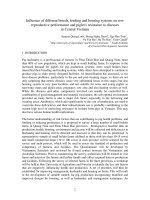Honda Vietnam,.Pdf
Bạn đang xem bản rút gọn của tài liệu. Xem và tải ngay bản đầy đủ của tài liệu tại đây (4.2 MB, 28 trang )
<span class="text_page_counter">Trang 1</span><div class="page_container" data-page="1">
Name: Dong Le Tung AnhStudent ID: HS171279Class: MKT1714
Lecturer: Tran Tuyet MinhPeriod: Spring 2023
MKT201 - CONSUMER BEHAVIOR
</div><span class="text_page_counter">Trang 2</span><div class="page_container" data-page="2">5. Impact of culture on Consumer behavior... 20
III. Conclusion... 22
IV. References... 23
</div><span class="text_page_counter">Trang 3</span><div class="page_container" data-page="3">1.1. Brand
Honda Vietnam, a joint venture with two industries, was founded in 1996 bythe Honda Motor Company (Japan), Asian Honda Motor Company (Thailand),and Vietnam Engine and Agricultural Machinery Corporation. Cars and motorbikes are the main products. Honda Vietnam has been operating in Vietnam forabout 30 years and has been steadily growing to become one of the topmotorbike manufacturers as well as a reputable auto maker in the country.With more than 10,000 people who constantly provide their best effort, sixmotorcycle factories that produce more than 23,000 thousand vehicles a yearand nearly 2.5 million motorcycles annually.
Understanding that motorbikes are the main and important means oftransportation in Vietnam, Honda Given that motorbikes are the primary modeof transportation in Vietnam, Honda Vietnam constantly makes an effort tooffer clients the finest motorcycle goods possible at competitive rates that areproduced in environmentally friendly facilities. Honda has consistently investedin developing manufacturing infrastructure since it first entered the Vietnamesemarket in order to fulfill the market's rising demand, where motorbikes make upalmost 90% of all vehicles in major cities.
Honda Vietnam officially obtained the Ministry of Planning and Investmentlicense permitting car manufacturing and assembly in Vietnam in March 2005,marking a significant historical turning point in the company's development.Honda Vietnam started its vehicle business in 2006, and after a little more thana year, the company has successfully established a factory, dealer network,sales, service, and training programs for clients on safe driving. The Honda
Introduction
</div><span class="text_page_counter">Trang 4</span><div class="page_container" data-page="4">Civic, the initial model, was introduced in August 2006 after the business hireddealers. In an ongoing effort to broaden its product line, the Honda Companydebuted the Honda City in June 2013 and the Honda CR-V model again inDecember 2008.
Honda Vietnam also imported high-end sedans and multi-purpose vehicles,the Honda Accord and Honda Odyssey, in order to meet everyday demand inaddition to domestically built automobiles. the more valuable the client. HondaVietnam began importing Honda Civic models in 2016 instead of continuing toproduce them locally. In order to meet the various needs of its consumers,Honda Vietnam has so far offered the Vietnamese auto market 3 models:sedans (big, medium, and compact), SUVs, and SUVs MPV.
In the Vietnamese market, Honda Vietnam has worked hard to establishitself as both a renowned vehicle and motorcycle manufacturer. HondaVietnam is pleased to offer clients top-notch goods, committed services, andcontributions to a civilized traffic culture. Honda's campaign, "Power ofDreams," aims to share and help everyone achieve their aspirations by bringingabout new joys for both individuals and society. Two fundamental beliefs, threedelights, and two essential beliefs form the cornerstone of the company'sprinciples.
</div><span class="text_page_counter">Trang 5</span><div class="page_container" data-page="5">Respect for people: Every human being is born as a free, unique individual,with the ability to think, reason and create and the ability to dream. “Respectfor people” requires Honda to promote and develop these ethos within thecompany by respecting individual differences and trusting each other as equalpartners. Trust: The relationship between Honda members is based on mutualtrust.
The understanding of treating people with respect, giving to those in need,accepting assistance when needed, sharing knowledge, and making realcontributions to fulfill obligations all contribute to building trust.
3 joys: The delight of buying is attained by offering goods and services thatfully satisfy each customer's wants and expectations; the joys of selling andcreating are attained when the quality of the product is higher than that of thebuyer. by means of anticipation. The pleasure of Honda customers and dealersis attained via individual efforts made in a team when Honda members andsuppliers are involved in the creation, design, and production of Honda goods.Honda's corporate mission is to "maintain a global viewpoint and aim toproduce the greatest quality goods at competitive rates to please customersworldwide."
Management philosophy:
- Always approach new opportunities with ambition.
- Respect sound theory, generate fresh concepts, and efficiently spend yourtime.
- Have pleasure in your work and promote open communication.- Always aiming for a productive working environment.
1.2. Product
Honda's product ranges have expanded throughout time to fulfill the widerange of consumer needs, including those for utility, luxury, fuel efficiency,fashion, and environmental friendliness. Honda Vietnam only had two productlines from the time it was founded until 2002: Super Dream and Future.
</div><span class="text_page_counter">Trang 6</span><div class="page_container" data-page="6">However, as of now, there are a total of 39 different types of 14 product lines,including 7 scooter lines (SH, SH mode, PCX, Air Blade, VISION), 5 digital cars(Future, Blade, WAVE RSX, Wave Alpha), and 2 clutches (Winner & MSX).All those who need to travel by motorcycle could be considered HondaVietnam's target market. For instance, middle-aged people are the targetmarket for the Super Dream car line, but people with a good income or higherand a sporty sense of style are the target market for the Future line. Customerswho favor a sporty look but make a decent living or less are targeted by theWave range. Honda's scooter line caters to young individuals with fashionableand trendy tastes. Last but not least, a series of masculine manual clutcheswith a strong personality is available.
1.3. Service
Honda is a firm that specializes in producing motorcycles and popular vehicles,but they also offer some of the best customer service in the world. Their goal isto provide every traveler in the world with the finest possible customerexperience. Honda is aware that "Satisfied customers is the best businessstrategy," and this statement applies to all company endeavors in all sectors ofthe global economy. Maintaining an existing customer is far less expensivethan finding new ones. Since its beginnings in Vietnam, Honda Vietnam has
</div><span class="text_page_counter">Trang 7</span><div class="page_container" data-page="7">always aimed to provide consumers with high-quality services in addition toproducts that include cutting-edge technology, superior quality, andunmatched safety. In order to maintain and improve the reputation of HondaAutomobile Vietnam, Honda Vietnam is proud to be a car company thatconsistently provides clients with the best sales and after-sales services inaccordance with the most professional worldwide standards. Honda hasdemonstrated this by consistently winning the CSI customer satisfaction indexfor many years in a row, according to a J.D Power Asia Pacific organizationsurvey.
In addition, Honda Automobile Vietnam's nationwide dealer networkconsistently provides sales and after-sales services that adhere to professionalworldwide standards, focusing on the needs and satisfaction of consumers.Customers here will be looked after in accordance with Honda Vietnam's 5Sstandards: Sales: Working to ensure that customers can access and purchasegoods and services, acting in a way that promotes client comfort, safety, andsatisfaction. Operations to address customer needs for maintenance and sparepart replacement are known as "spare parts." Efforts to teach customers safedriving techniques and information include Social contribution: Initiatives thatbenefit and advance society. In particular, the entire Honda Automobilessystem is in compliance with the Green Dealer standard and is operational andcertified with ISO 14001: 2010 by the General Department of Standards,Metrology, and Quality assure adherence to the exact environmental criteria setout by ISO 14001:2010. In order to provide consumers with the bestopportunity to experience Honda Vietnam's automotive products, Dealers alsooffer a monthly test drive program at the Dealer or upon request.
</div><span class="text_page_counter">Trang 8</span><div class="page_container" data-page="8">2. STP Strategy
2.1. Honda's segmentation
According to Philip Kotler, market segmentation “involves dividing a marketinto distinct groups of buyers who have different needs, characteristics, orbehaviors and who might require separate marketing strategies or mixes”.Honda defines the market as "any person with a driver's license." To segmentthe market, Honda examines the four bases of market segmentation:geographic, demographic, psychographic, and behavioral, and decides whichare relevant to their product and how they are relevant. By understanding thespecific needs and characteristics of different segments of the market, Hondacan tailor their marketing efforts and messaging to effectively reach andengage with these groups.
Honda uses demographics, geography, psychology, and behavior as metricsto divide the market into segments. Even if it wants to keep the company'sconsistency across the system, the company builds a differentiation strategy tospecialize its stores. Each establishment in different areas will have differenttypes of products to meet the needs of local people based on preferences andneeds studied and identified by psychographic segmentation. Demographicsegments include the age, occupation, and income level of the target marketthat make up a company's consumer profile. Last but not least, behavioralsegmentation helps brands convince customers and go deeper into the user'smind.
2.2. Honda's market target
Market targeting “consists of evaluating each market segment’s attractivenessand selecting one or more market segments to enter”(Principles of Marketing,Philip Kotler 2017). After dividing the vast and diverse customer market intosmaller groups with homogenous characteristics, Honda wisely selected thetarget segment/segment whose needs and expectations match its resourcesand capabilities of the company. Honda uses a customer value-oriented two
</div><span class="text_page_counter">Trang 9</span><div class="page_container" data-page="9">marketing strategy to reach its target market. Honda evaluates the commercialattractiveness and growth potential of the identified segments to define itstarget market.
The company has different business segments such as automotive,motorcycles, financial services and energy, and a marketing mix productstrategy that covers all aspects of the business. Mainly the target market ofhonda is the middle-income group of customers because they mainly ride 2 frontwheels because it suits their pocket and at the same time offers value formoney. Talking about the past, Honda mainly aimed at the age group over 30 -51, but in the past few years, the company has hit a new market segment that isa group of young drivers and young families who already have a strong base.firmly in the market and will eventually lead to higher sales for the company. Inaddition to promotions and advertising, Honda also promotes itself throughsponsorship of sporting events and social initiatives. The company has alsolaunched campaigns like the #Cheerance campaign to support its annualSummer Clearance Sales Event. Honda also invests 5% of profits in researchand development of their product lines.
2.3. Honda's positioning
Positioning “consists of arranging for a market offering to occupy a clear,distinctive, and desirable place relative to competing products in the minds oftarget consumers.” (Principles of Marketing, Philip Kotler 2017). Brandpositioning and value proposition positioning are critical to marketplace success
</div><span class="text_page_counter">Trang 10</span><div class="page_container" data-page="10">in today’s competitive marketplace. Honda has positioned itself as a qualityautomaker that delivers value for money to its customers. The companycapitalizes on its strong capabilities in engine performance and quality, whilesupporting it with beautiful, stylish or luxurious designs and a high-qualityoverall package. The brand values initiative, ambition, equality and trust, and iscommitted to continuous improvement and lean operations. Honda haspositioned itself as a values-based company whose goal is to enrich the lives ofpeople worldwide and empower them to enjoy their lives. Honda is a globalbrand with a strong presence in the automotive and motorcycle markets, withNorth America being the leading market. Honda's product strategy andmarketing mix encompasses four business segments: automotive, motorcycles,financial services, and energy. The product marketing mix strategyencompasses all aspects of the business.
</div><span class="text_page_counter">Trang 11</span><div class="page_container" data-page="11">3. Aims
Through this Individual Assignment in Consumer Behavior (MKT201), I wantto apply and analyze what I have learned in this subject. Consumer behaviormay be affected by four factors: Cultural, Personal, Social, Psychological. Thebrand I will choose to analyze is Honda - one of the most famous motorcyclebrands in the world. On the other hand, Vietnam is my hometown - a beautifulagricultural country with the thickness and diversity of culture. I want toresearch and analyze consumer behavior in Vietnam to better understand ourpeople, our culture, factors affecting our purchase decision, habits andattitudes in choosing motorbike brand. My objectives after this assignment is tocollect, analyze, report and draw conclusions about the impact of Vietnameseculture on consumer behavior on motorbikes consumption in general as well asHonda's motorbikes in particular.
</div><span class="text_page_counter">Trang 12</span><div class="page_container" data-page="12">Definition of culture and related factors1.
According to Solomon and Micheal R in Consumer Behaviour, Culture “is asociety’s personality. It includes both abstract ideas, such as values and ethics,and material objects and services, such as the automobiles, clothing, food, art,and sports a society produces. Put another way, it’s the accumulation of sharedmeanings, rituals, norms, and traditions among the members of anorganization or society. According to E.B. Taylor in "Primitive Culture" 1871:"Culture or civilization, in the broad ethnographic sense, is generally formedfrom knowledge, belief, art, morals, law, custom and a number of othercapacities and habits acquired by man as a member of society”.
More generally, culture is all the products that people have created in theprocess of living and interacting with society. Geert Hofstede defined culture as"the collective programming of the mind that distinguishes members of a groupor a group of people from others'' in his 1980 book "The Consequences ofculture: International differences in work-related values”. According tosociologists, culture consists of the values, beliefs, systems of language,communication, and practices that people share in common and that can beused to define them as a collective.
Culture also includes the material objects that are common to that group orsociet. In C. Marx's concept, culture is what shows the liberation and self-liberation of people from bondage, domination with a mysterious power of thenatural world and the divine world that people imagine. imagined by hispowerlessness before the enigmatic world of nature. But according to UNESCO'Culture is the living whole of past and present activities and creations. Overthe centuries, that creative activity has formed a system of values, traditions


